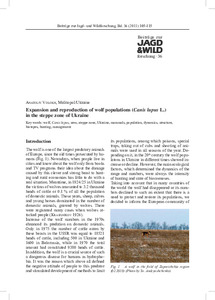Please use this identifier to cite or link to this item:
http://elar.tsatu.edu.ua/handle/123456789/4179Full metadata record
| DC Field | Value | Language |
|---|---|---|
| dc.contributor.author | Volokh, Anatolii | - |
| dc.contributor.author | Волох, Анатолій Михайлович | - |
| dc.contributor.author | Волох, Анатолий Михайлович | - |
| dc.date.accessioned | 2018-06-26T08:04:07Z | - |
| dc.date.available | 2018-06-26T08:04:07Z | - |
| dc.date.issued | 2011 | - |
| dc.identifier.uri | http://elar.tsatu.edu.ua/handle/123456789/4179 | - |
| dc.description.abstract | Present populations of the wolf in the steppe zone of Ukraine started their formation in the 1970s. At first, it was assisted by the reduction of hunting press, and later by appearance of a high number of fields overgrown with weed. Penetration of the wolf into the south of the country went from different directions. In the west of great importance were groups of the wolves, survived in the territory of Moldova Republic and in the north of Odesa region; in the north it was at the expense of the population inhabiting the forest zone; in the east there were centres of the wolf habitations, located in forests of the Syverskyi Donets River and in borderline districts of Russia. By 2000 the wolf had inhabited all the administrative regions of the steppe Ukraine. In 1984 the appearance of this animal was recorded on Kerch Peninsula in the Crimea, although its basic expansion to this area began in the first years of the 21st century. The most suitable biotopes for this species in the studied region are sunflower plantations, tall weeds and the gullies overgrown with trees and shrubs, although quite often these animals can be seen in the fields deprived of vegetation. In the steppe zone of Ukraine to make a dwelling for their litter wolves predominantly use holes (51.62 %), then open dens (25.81 %) and specially digged burrows (16.13 %). Most often in flat areas of the steppe zone wolves made dens for cubs in forest belts and blackthorn bushes, whereas in broken terrain they made them in gullies. The average size of the wolf litter in the steppe zone of Ukraine is 5.5±0.13, the smallest – 2, the largest – 12 cubs. Regional differences of this index are insignificant. The smallest number of сubs in 1 den was revealed in Odesa region (5.0±0.16), the highest – in Lugansk region (6.5±0.37). In transformed steppe ecosystems the wolf populations requires management of their numbers and spatial distribution. It will allow to limit further growth of their numbers as well as save some centres of its distribution. | uk |
| dc.language.iso | en | uk |
| dc.relation.ispartofseries | Beiträge zur Jagd & Wild forschung;Bd. 36 (Pp. 105-115) | - |
| dc.subject | wolf | uk |
| dc.subject | Canis lupus | uk |
| dc.subject | area | uk |
| dc.subject | steppe zone | uk |
| dc.subject | Ukraine | uk |
| dc.subject | mammals | uk |
| dc.subject | population | uk |
| dc.subject | dynamics | uk |
| dc.subject | structure | uk |
| dc.subject | biotopes | uk |
| dc.subject | hunting | uk |
| dc.subject | management | uk |
| dc.title | Expansion and reproduction of wolf (Canis lupus L.) populations in the steppe zone of Ukraine | uk |
| dc.type | Working Paper | uk |
| Appears in Collections: | Кафедра Геоекологія та землеустрій | |
Files in This Item:
| File | Description | Size | Format | |
|---|---|---|---|---|
| 2011 Expansion and reproduction of wolf populations (Canis lupus L.).pdf | 505.05 kB | Adobe PDF |  View/Open |
Show simple item record
CORE Recommender
???jsp.display-item.check???
Items in DSpace are protected by copyright, with all rights reserved, unless otherwise indicated.
